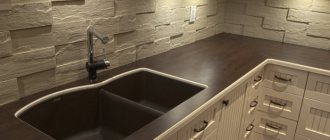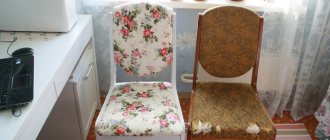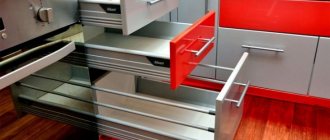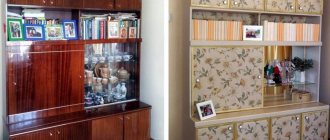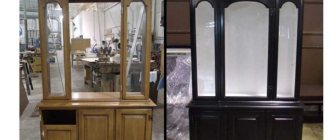Types of furniture
Any material from which furniture is made has its own characteristics. This must be taken into account when operating and caring for it. Furniture in the kitchen, if the hood works properly, does not require any special care.
Standard methods are also suitable for furniture in the bedroom or living room. Caring for upholstered furniture is not at all difficult; it is only important to take into account the material when cleaning it and know a few simple rules.
Operating rules
The safety and durability of furniture products depend on careful use and care. To avoid problems that could spoil the joy of your purchase, we kindly ask you to take note of this Consumer Information and follow its recommendations.
Furniture quality
When making a selection (acceptance) of goods, exercise caution regarding the size, color, texture, shape and other similar qualities of furniture, since the right to exchange goods of good quality, provided for in Art. 25 of the Law of the Russian Federation “On the Protection of Consumer Rights” of February 1992 2300-1, in accordance with the Decree of the Government of the Russian Federation of January 19, 1998 No. 55 does not apply to furniture.
The Customer gets acquainted with the Contractor's warranty obligations and the rules for operating the furniture. The contract is subject to preservation during the warranty period and is provided to the Contractor upon presentation of claims about the non-compliance of the goods with the terms of the contract.
General conditions for use (storage) and care
1. The period during which furniture retains its beauty and serviceability depends significantly on the conditions of its use.
2. Each piece of furniture is intended for a specific purpose of use, therefore any furniture product should be used in accordance with its functional purpose.
3. By following some simple practical tips, you can keep all the elements of your furniture in the best condition. Before using the product, the Customer must carefully read the furniture care instructions. Violation of the rules for operating furniture deprives the Customer of the right to warranty service.
4. Climatic characteristics and environmental conditions. It is very important to understand how climatic characteristics and environmental conditions can affect the appearance and quality characteristics of furniture. Since furniture products are sensitive to light, humidity, heat and cold, it is recommended to avoid prolonged exposure to one or more of these factors.
Light
Avoid direct exposure of furniture to sunlight. Prolonged direct exposure of some areas to light may cause a decrease in their chromatic characteristics compared to other areas that are less exposed to radiation. If components are replaced and/or added at different times, color differences may occur between the elements that make up the furniture. This difference, which will become less noticeable over time, is completely natural and therefore cannot be considered a sign of low quality furniture.
Temperature
High levels of heat or cold, as well as sudden changes in temperature, can seriously damage the furniture product or its parts. Furniture products must be located at a distance of at least 1 m from heat sources. Recommended air temperature during storage and (or) operation is from +2C to +25C. Do not allow furniture to come into contact with hot objects (irons, dishes with boiling water, etc.) or prolonged exposure to radiation that causes heating (light from powerful lamps, unshielded microwave emitters, etc.).
Humidity
1. Recommended relative humidity of the location of the furniture product is 60% -70%. Extreme humidity conditions should not be maintained indoors for long periods of time. Over time, such conditions can affect the integrity of furniture products or their components. Always keep the furniture surface dry. The surfaces of furniture parts should be wiped with a dry soft cloth (flannel, cloth, plush, calico). Care of work surfaces (countertops, sinks, etc.), as a rule, should be carried out with a soft damp cloth, a foam sponge or special brushes, possibly using appropriate detergents. It is recommended to clean any part of the furniture as soon as possible after it gets dirty. If you leave the contamination for some time, the risk of streaks, stains and damage to furniture products and their parts increases significantly. In case of persistent stains, it is recommended to use special cleaners, which are currently available in a fairly wide range and, in addition to proper cleaning properties, have polishing, protective, and flavoring properties. In this case, it is necessary to follow the instructions of the cleaner manufacturers regarding the order and area (for which surfaces and materials are intended) of their use. In the absence of special means, care (cleaning) is also allowed using a small amount of an aqueous solution of a neutral detergent (for example, 2% detergent, 98% water). Upon completion of any cleaning, immediately dry (wipe dry) all parts that were wet cleaned. It is recommended to pay special attention to internal and poorly ventilated parts, to extremities and to connection points. Remember not to use cloths, sponges or gloves soaked in products that should not come into contact with the materials being cleaned.
2. Aggressive environments and abrasive materials. Under no circumstances should furniture products be exposed to aggressive liquids (acids, alkalis, oils, solvents, etc.), products containing such liquids or their vapors. Such substances and compounds are chemically active - a reaction with them will have negative consequences for your property or even health.
Ventilation
It is recommended not to obstruct grilles and air intake openings required for ventilation of electrical appliances.
Features of operating and maintenance conditions
1. Furniture for sitting and lying. Chairs, stools, beds, banquettes, sofas, benches, etc., are functionally intended only for sitting and lying. To avoid accidents and damage to furniture, do not allow children to jump on the bed or swing on chairs and chairs (except rocking chairs). Furniture for lying down - a bed - consists of a functional part designed to bear the load during operation - a mattress pad on legs, a mattress - as well as a decorative part that is not a supporting element - drawers, footboards and headboards of the bed. You should not use elements of the decorative part of the bed as support (leaning on them, sitting on them). It is recommended to place the bed in such a way that the back of the headboard is located close to a wall or other flat vertical support. It is not recommended to stand with your feet on the bed or jump on the bed. Do not rub or hit furniture surfaces with sharp (cutting) or heavy hard objects. If your furniture has removable covers, use the services of special dry cleaners to remove dirt.
2. Remember: there is not a single type of upholstery fabric that has a removable cover that can be washed. Therefore, in this furniture, the use of water to remove stains should be limited. To remove dust and keep your furniture in good condition, the fabric can be vacuumed. Dust can also be successfully removed using a cloth, sponge or soft brush.
3. Cabinet furniture (cabinets, shelving, hallways, kitchens, tables, cabinets, etc.) must be used in accordance with the functional purpose of each individual item.
4. Features of the operation of cabinet furniture. All weights should be placed inside the cabinets in such a way as to achieve uniform distribution of the load over the entire available area and ensure the necessary balance of the sliding parts. It is recommended to place things on the shelves according to the principle: the heaviest ones are closer to the edges (supports), the lighter ones are closer to the center. It is recommended that tall elements (columns, multi-tier cabinets, etc.) be loaded more in the lower sections to ensure better stability of these elements. When using cabinet furniture, static vertical load is not allowed. Especially with the application of force to one point: on the bottom of drawers (half-drawers) - more than 5 daN*, on shelves (cabinets, racks) - more than 10 daN*. The normal force for opening doors is up to 3 daN*, the force for pulling out drawers (half-drawers) is up to 5 daN*. Note:* - a load (force) of 1 daN approximately corresponds to the impact of a weight of 1 kg. Do not rub or hit furniture surfaces with sharp (cutting) or heavy hard objects. We draw your attention to the fact that elements of kitchen units located near a gas or electric stove are subject to increased thermal load, which is why it is recommended to separate them from heat sources with appropriate thermal insulation materials. Please note that only special “built-in” household appliances can be installed in furniture products. Such equipment is carried out by manufacturers in accordance with specific standards and technical conditions (electrical safety, moisture removal, heat exchange, ventilation, etc.) and, as a rule, costs slightly more than “non-built-in” analogues. Remember: under no circumstances should you use ordinary household appliances as built-in ones; this can pose a real danger to the life or health of people and (or) the safety of property!
Features of caring for cabinet furniture
1. When caring for decorative and working coatings, products must be used that correspond to the nature of the coating material. We bring to your attention some examples.
2. “Laminate” surfaces. In addition to the general care conditions (see above), it is possible to use polishes for plastics. At the same time, for polishing (processing) kitchen furniture, you cannot use polishes (other household chemical products) that have contraindications for contact with food - read the instructions carefully! Avoid using hard tools (scrapers, sponges coated with plastic or metal fiber-like material) when cleaning.
3. Furniture parts made of rattan and bamboo. Remove dust from wicker furniture parts using a vacuum cleaner and clean with a damp cloth. Limit exposure to direct solar radiation and heat near heating sources (changes in color shades and binding density).
Glass surfaces
It is recommended to clean glass with special compounds applied to a soft cloth. For cleaning, use special glass cleaners. Do not use products with abrasive properties, or sponges coated with metal fiber-like or chip-like material when cleaning. The use of soda, washing powders, abrasive pastes, powders and other preparations not intended for the care of furniture is not allowed. Remember, glass surfaces are fragile and may break if struck. Do not rub or hit surfaces with heavy, hard objects. Do not expose glass shelves to large vertical loads.
Mirror surfaces
1. It is not recommended to wash with conventional synthetic products intended for cleaning windows. They can cause mirrors to become stained and cloudy. Dry cleaning is also undesirable. This may leave scratches on the surface. It is best to wipe mirrors with ammonia or a special mirror cleaner.
2. Glossy, acrylic surfaces. Under no circumstances should you use any caustic or abrasive cleaners on them, as this may damage the brilliant shine of the surface. Under no circumstances should detergents containing alcohol be used. There is also no need to use waxes and polishes intended for furniture, since they contain solvents that cause the film to become dirty. Using products that contain solvent to clean the surface can damage the surface, as cracks will appear on it that cannot be removed. In addition, you cannot use cleaning products that contain acids and clean the surface by rubbing. It is not advisable to use cleaning products that evaporate quickly. Such products can significantly damage the surface of your facade. Do not wipe the surface with abrasive cloths or dishwashing sponges to avoid scratching the acrylic surface. It is contraindicated to clean the surface with steam; a large amount of humidity can also damage the surface. Therefore, remember that you need to clean the surface of the facade with soft cloths soaked in a 1% soap solution and a special ULTRA-GLOSS+DGS product, which, in addition, also polishes any scratches that appear.
Rules for the operation of MDF facades under PVC film. It is forbidden:
1. Expose furniture facades to heat above +70 ° C (open oven, heated stove, lighting fixtures and heaters, hot steam, etc.), because this can lead to deformation and peeling of the film.
2. Subject to mechanical impact (contact with sharp objects, friction, impact)
3. Remove the protective film from facades covered with glossy film until the furniture installation process is completed.
4. Use abrasive powders and solvents (acids, alcohol, acetone, gasoline, etc.) to care for facades and clean surfaces. Use a damp, soft cloth and non-aggressive detergents.
Rules for the use of MDF facades - enamel
1. MDF facades coated with enamel are intended for installation on residential cabinet furniture. The products are environmentally friendly, have high wear resistance, resistance to fading, cracking and abrasion. However, to extend the service life of enamel facades, the following rules for their operation must be observed:
2. The maximum permissible temperature of frontal exposure to the product should not exceed 120 degrees (long-term exposure to temperatures - no more than 70°C). If this rule is not followed, there is a risk of fading and cracking of the enamel.
3. It is not allowed to use cleaning agents containing abrasive particles (powders), solvents, acetones, acids, alkaline liquids, except for those specifically intended for washing and polishing furniture.
4. To avoid local changes in the color of the enamel, installation of lighting (spotlights, etc.) is carried out at a distance of at least 150 mm from the product.
5. The main point that you need to pay attention to is that enamel facades often contain traces of hand stains, and enamel facades are also easy to scratch. Therefore, when caring for these facades, the following instructions should be followed.
6. A regular microfiber cloth will help you deal with hand stains (as well as water stains), which will remove dirt without leaving a trace. To reduce stains, try to open cabinets only by the handles. When removing stains and dirt from enamel facades, you can also use a warm, mild soap solution. It is possible to use any solutions of commercially available cleaning products for varnished furniture. After the cleaning operation, the surface should be rinsed with clean water and dried.
Metal surfaces
Do not use products that have abrasive or corrosive properties, or sponges coated with metal fibers or flakes when cleaning. After cleaning, a spectacular shine to the surface is achieved by polishing it with a soft, dry cloth in a reciprocating motion.
Sliding doors
1. To maintain the excellent appearance and long-lasting operation of sliding doors (closet systems), follow a few simple recommendations. Periodically clean the lower guide rails from dirt and dust with a vacuum cleaner, otherwise they will wrap around the wheel and interfere with the smooth movement of the doors. Do not expose system profiles and door filling materials to mechanical damage or exposure to chemicals not intended for this material. Be careful not to get large amounts of moisture into the sections of the sealing materials.
When using furniture, the maximum load on one internal shelf
-with a horizontal size from 15 to 30cm is 15kg.
-with a horizontal size from 45 to 60cm is 12kg.
-with a horizontal dimension of 90cm is 10kg.
-maximum load on retractable elements is 15kg.
It is strictly forbidden to treat stained glass with solvents, other aggressive liquids, soda, or abrasive cleaning agents.
Useful prevention
1. After a certain period of use, some mechanical parts (hinges, locks, etc.) may lose the optimal adjustment and lubrication performed during assembly of the furniture product. Such phenomena can be expressed in creaking, difficulty opening doors or pulling out drawers. Therefore, when using household furniture, you should not use excessive force to open doors, drawers and other moving parts. Their proper operation is ensured by timely adjustment of the hinges or lubricating the guide rails with paraffin or a similar product. If threaded connections become loose, they must be tightened periodically. It is not recommended to close any mechanisms with closers with force, because This causes the closers to deteriorate and may break.
2. You can clean furniture handles with a soft damp cloth. It is not recommended to use powders or active alkaline pastes, which can scratch the surface of products.
3. When completing the set with built-in household appliances, you must follow the rules for operating this household appliance in accordance with the operating instructions.
4. When using countertops coated with artificial stone, it is recommended to place metal and heavy (more than 5 kg) objects on a special stand for pots, and to use cutting boards when cutting food.
5. The heat resistance of countertops coated with artificial stone is no more than 110 C, therefore, when using gas stoves, a special protective screen (casing) is required to prevent contact of hot combustion products with the surface of the wall panel or wall edge.
6. When using countertops coated with artificial stone, do not allow impacts with heavy objects. If scratches or stains occur, the surface of the tabletop can be updated with polishing sandpaper.
7. To remove contaminants on the surface of artificial stone, it is allowed to use FARY type detergents that do not contain abrasive particles and fat-based cosmetic additives for skin care. The use of products such as Pemosol and Pemolux is prohibited. The abrasive powder on which these products are made leaves micro-scratches on the surface, which make the surface rough and spoil the appearance of the product.
8. Heavy dirt and dried colored stains are removed with a sponge and washing liquid. To remove stubborn stains, apply washing powder to them and leave for a while.
9. Lime stains are removed with vinegar, citric acid or liquid means for removing limescale from metal surfaces.
10. Prolonged contact of artificial stone surfaces with solvents and aggressive liquids containing acetone and styrene is not allowed. After cleaning, rinse the artificial stone surface with water and wipe dry with a soft cloth.
When using products made of solid wood or veneer, for better and durable use, we recommend that you adhere to some basic rules
1. Humidity in the room should not be lower than 40% and higher than 60%. In winter, humidity usually drops to 15-25% and this can lead to loss of natural moisture in the wood and, as a result, the formation of small cracks, which then disappear with increasing moisture. To avoid this, we recommend using a humidifier in winter.
2. Avoid direct exposure to sunlight, this may lead to gradual fading of the area exposed to direct sunlight.
3. Clean and care with products that contain wax. Do not use abrasive products, as well as products containing alcohol additives or solvents.
4. Wood is a natural material and therefore each type of wood has its own shape, color and structure of wood fibers. The beauty of natural wood is characterized by the fact that structure, shape and color are not a constant and repeating value. These parameters are a key characteristic of many furniture components and mean that when processing wood it is impossible to achieve uniformity of all indicators and you can always find places where the structure of the fibers differs from each other, where the color tone slightly changes its shade, depending on the density of one or another piece of wood. The combination of all these factors ultimately makes wood products so “alive,” natural and beautiful.
Acrylic stone care
1. Perhaps the most important thing is to remove stains in a timely manner. It is easiest to remove any stains from acrylic immediately after they appear. To do this, just use a damp soft cloth. If this method does not help, use a soap solution. It will help remove any contamination.
2. Despite all the durability of the surface, it is necessary to use cutting boards for cutting vegetables and fruits, since after several months of contact with a sharp knife, scratches may appear on the composite. Hot objects also need to be placed on a special stand to avoid surface deformation - not everyone can withstand temperatures up to 300ºC.
3. Polishing also ensures proper care of the artificial stone and, again, does not require much effort and time. To carry out this procedure, it is worth purchasing special products intended for use on acrylic surfaces.
Strictly prohibited
1. Acrylic stone, like any other material, has its contraindications. Thus, metal sponges and harsh cleaning agents should not be used to remove stains. Most likely, acrylic will withstand several such contacts, but very soon scratches will become noticeable.
2. Remember: how we care for countertops and other surfaces made of artificial material will determine their service life.
Recommendations for caring for glass art products
1. Modern stained glass is made using imported self-adhesive stained glass films and metal tapes.
2. The high quality of the materials used, tested in accordance with international standards, is ensured by the use in their production of polyester resins and dyes with increased resistance to ultraviolet radiation. The basis of the color film is the self-adhesive Mylar component, which is part of polyacrylic films. The dye that gives color to tinting films does not fade or fade, and is resistant to humidity and extreme temperatures. The surface of the film additionally has a protective layer that absorbs 90% of natural ultraviolet radiation. The colored shell of metal tapes is made on the basis of heat-treated polyester resins with an admixture of various natural pigments and dyes. The surface layer of the metal tape is resistant to ultraviolet radiation.
3. Stained glass windows made on plastic or plexiglass are not recommended to be installed in places where they will be exposed to direct sunlight or near heat sources (heating devices, high-power lighting sources) in order to avoid deformation and, as a result, peeling of the films.
4. In order to ensure the preservation of the appearance of the artistic product, it is recommended.
5. Avoid mechanical impact on the materials from which the stained glass window is made.
6. Avoid long-term contact with water.
7. To remove dust and dirt, wipe stained glass windows with lint-free wipes, paper towels or a soft cloth using liquid detergents that do not contain alcohol and alcohol compounds (for example, “Mr. Muscle”);
8. It is strictly prohibited to use abrasive substances to care for stained glass products.
9. Stained glass does not require maintenance if it is installed inside a double-glazed window.
Delivery, acceptance and assembly of furniture
FURNITURE DELIVERY
1. Represents the movement (loading, transportation, unloading, lifting, transport forwarding) of furniture from the place of its manufacture to the address specified by the Customer.
2. It is recommended to use the delivery service provided by the Contractor or specialized organizations that have equipment, vehicles and personnel suitable for these purposes.
3. It is not recommended to deliver furniture products yourself.
4. Remember: defects in furniture products resulting from independent delivery cannot be corrected under warranty.
Acceptance of furniture
1. Upon receipt of the goods (both in the warehouse and upon delivery), it is recommended to check the furniture for its completeness and external quality features. You should open the packaging, inspect the front panels, mirrors, glass elements, check the presence and completeness of the fittings, and make sure there are no visible defects (rough scratches, chips and obvious dents).
2. It must be remembered that acceptance of furniture without indicating obvious defects that could have been discovered during the usual method of acceptance (inspection) deprives the buyer of the right to subsequently refer to them and make claims on them.
3. In this case, the following are not considered a defect or defect in the furniture:
In accordance with generally accepted standards, the quality of the appearance of a product is assessed under normal conditions:
1. Visually for at least 30 seconds.
2. Without the use of magnifying agents.
3. In daylight or identical to daylight.
4. At a distance of 50cm at an angle of 90 degrees to the surface of the product.
Permissible deviations in the parameters of the materials used and technological parameters in the production of furniture are regulated by Interstate Standards (GOST 16371, GOST 19917).
General tolerances
1. Any deviations that are not noticeable when assessed under normal conditions are allowed on the front, end and back surfaces of the product.
2. On the front surface: “shagreen” with a deviation from the plane of no more than 0.05 mm (barely noticeable when assessed under normal conditions).
3. On the back surface: seals in an amount of no more than 3 per 0.3 m2. each no more than 6 mm in size (no more than 3 pieces on a medium-sized workpiece).
REMEMBER:
acceptance of furniture without indicating the defects of furniture products that could have been identified during the usual method of acceptance (obvious defects) deprives the Customer of the right to refer to them in the future. The presence in its elements of features determined by the stylistic idea of the manufacturer of the source materials, etc. is not a disadvantage (defect) of the product. The fact of acceptance is reflected in the Transfer and Acceptance Certificate (invoice) and is confirmed by the Customer’s signature.
Furniture assembly
It is recommended to use the assembly service provided by the Contractor, who has equipment, tools, technologies and personnel suitable for these purposes, since in this case the Contractor is responsible for the quality of the service provided. It is not recommended to independently assemble furniture purchased in disassembled form, or to “repair” or “improve” it, or to resort to the help of specialists of dubious qualifications for these purposes. The simplicity of assembly, which is obvious at first glance, is apparent. Proper assembly requires professionalism (the presence of the necessary knowledge and skills), knowledge of the technological features of manufacturing furniture products, the properties of materials and structures, processing techniques, and installation sequence.
ATTENTION!
In the case of self-assembly or unskilled assembly, it is possible not only that defects may arise in the products (their elements) and, as a consequence, the loss of the right to warranty service.
Warranty service is NOT PROVIDED in case of
1. Expiration of the warranty period.
2. Failure to comply with operating conditions.
3. The presence of mechanical damage and defects on the product, traces of foreign interference in the product resulting from improper operation, unqualified assembly, repair and transportation.
4. Exceeding the permissible loads on the product.
5. Damage to the product as a result of intentional or erroneous actions of the consumer.
6. Damage to the product caused by foreign objects (liquids, animals, insects, etc.) getting inside the product.
7. The warranty does not apply to swelling of the laminate as a result of improper use of furniture, for example: under the influence of water or steam, high temperature, strong radiation sources, etc.
8. Damage to the product as a result of changes to its design.
9. Using the product for production purposes.
ATTENTION! Manufacturing defects of the product are not:
1. Features due to the texture of the material or style of the product, such as minor (not noticeable) color differences or differences in the texture of product elements.
2. A slight color difference between the elements of the product and the samples presented in catalogs and other printed products, which is determined by the peculiarities of printing.
3. Slight color difference between product elements and samples displayed in retail outlets, since the color of surfaces may change during storage and use.
4. For the reason stated above, a discrepancy in color between replacement elements or elements on additional orders with previously purchased furniture is not considered a defect.
5. Normal abrasion of the coating in areas of frequent touch.
6. Loose connections, decreased mobility of hinges and locks, complications in the movement of doors and drawers during constant use, caused by lack of product care.
Failure to comply with the above conditions and recommendations, resulting in defects in the furniture product, is grounds for loss of the right to warranty service!
Wooden furniture
Rules for caring for wooden furniture include protecting it from insects. For prevention, every spring the lower part of the furniture is rubbed with turpentine. Using a cloth moistened with vegetable oil, you can refresh the surfaces.
An eraser will help remove stains from varnished surfaces. Traces of scratches are rubbed with walnut, then polished with cloth. Instead of a walnut, you can use wax or a paraffin candle. If mold appears somewhere due to dampness, remove it with a sponge soaked in gasoline. Iodine will help deal with scratches on mahogany.
Tips for cleaning furniture made of wood, chipboard
Wooden facades and countertops do not tolerate products with abrasive properties - this should be taken into account when choosing sprays.
Due to the alkali content, you also have to give up laundry soap and washing powders. The use of sponges with an abrasive surface is strictly prohibited. It is optimal if, after care, the polished surfaces are rubbed with felt or a plush napkin. Completely exclude contact of furniture with any chemical reagents. The wooden surface and varnish may be damaged due to drops of paint and stain removal solvents. The exception is the presence of a stain. In this case, you will have to use chemicals, being prepared for a negative impact on the furniture.
For metal elements, a wipe with a suede or plush cloth is usually sufficient. It is important to avoid contact with abrasive components, eliminating friction with other metal objects in the interior. As a result of friction, for example, with a stove or radiator, the top layer of furniture may be damaged.
If stains appear on glass surfaces, we can recommend special products and cotton napkins. A soda solution is not suitable for removing greasy stains from the fronts of cabinets, countertops and other surfaces. The reason is in sodium bicarbonate crystals, with abrasive and alkaline properties.
Mahogany furniture and doors made of precious wood without polishing require special care. You can refresh the beauty of furniture using vinegar, burdock oil or wax (diluted in warm turpentine). Furniture made of walnut, oak or mahogany may experience scratches during use. They can be visually hidden using a weak iodine solution.
Over time, metal parts may lose their original shine.
You can restore their beauty with a special mixture containing ammonia (30 g), powdered chalk (15 g) and water (50 g). Shake the resulting liquid, wet a flannel cloth and begin wiping. The part should be rubbed until shiny using a cloth. To care for varnished coatings, a composition for washing thin fabrics is suitable, which we moisten with a damp cloth. After cleaning, do not forget to wipe the surfaces dry.
For walnut wood, a combination of dry red wine and olive oil is used. For pianos, use natural drying oil or polishing liquid. For white keys, you need water or alcohol with the addition of hydrogen peroxide in a ratio of 1 tsp. for 500 gr. water. Turpentine is preferred for caring for black keys.
Oak furniture also deserves careful care. To do this, add a mixture of wax (20 g), sugar (1 tsp) and beer (one glass). Bring our mixture to a boil, then cool slightly. Apply the mixture to the furniture using a cotton swab. After the oak furniture has dried a little, rub the surface with a dry cloth.
The appearance of polished furniture may be affected by stains. In this case, you should use a mixture containing vegetable oil and alcohol in a 1:1 ratio. To apply the solution, use a woolen rag until the stains disappear. An alternative is to rub it with a piece of paraffin wax, ironing it with a not very hot iron through blotting paper.
Wicker chairs, stools, planters, baskets and straw furniture deserve salt water treatment. For coatings treated with furniture polish, stain, or containing wax, it is important not to overdo it with wet processing.
To clean polished furniture, you can use a soft cloth soaked in tea leaves or milk. After wiping, wipe the surface dry with a soft cloth.
To get rid of stains from water and other liquids on oak furniture, you need to use cigarette ashes, which we mix with a small amount of vegetable oil.
Matte surfaces
In case of serious contamination, you can wash with soap and water and immediately wipe well with a dry cloth. Do not use polish, otherwise it will leave greasy stains on the surface.
Metal parts are treated with a solution containing:- 100 g water;
- 30 g of ammonia;
- 15 g chalk or tooth powder.
The powder is first dissolved in half a glass of water, ammonia is added and mixed thoroughly. The resulting white slurry is applied to metal elements, allowed to dry for 20-30 minutes, then rubbed with a cloth.
Tips for caring for oak, walnut and mahogany furniture
Staining
To give light oak furniture a dark color, you need to place it in a dark room (there should be several vessels with ammonia in the room). As it sits, vapors will be released that contribute to the dark, smoky color of the furniture. The time the furniture spends in this room is selected taking into account the preferred color at the exit. For this, an option with regular stain is also possible.
Cleaning
If oak furniture becomes heavily soiled, you need to get rid of the dust with a napkin, then wipe it with a damp piece of leather (with careful squeezing), polish the surface with a woolen rag when it dries.
Furniture smells
Furniture can absorb some odors; to eliminate them, you should use a weak solution of potassium manganese. We wash the drawers with it without closing it until it dries.
Furniture staining
Staining is done using ready-made stains of different compositions. For wooden furniture, sanding with fine-grained sandpaper is necessary before staining; a brush allows you to get rid of wood dust.
If the wooden surface is cut across the grain, slight wetting is required before staining. Apply stain using a brush without a metal ring. Repeat staining until the surface dries.
After drying, the stained surface is treated with colorless varnish or polish. They are applied with a brush or a linen rag rolled into a ball. After drying, the surface must be sanded using fine-grained sandpaper and re-varnished.
To remove stains or scratches on oak furniture, edged wood or walnut surfaces, you can use a weak iodine solution applied with a brush.
To remove stains from oak furniture, you need to use warm beer; to make the surface shine, you should use a warm boiled mixture. It contains 1 tsp. sugar, 1 glass of beer and a small piece of wax.
For mahogany furniture, burdock oil should be used. To refresh mahogany furniture, use a thoroughly wrung out cloth and wipe dry with a linen cloth.
For walnut furniture, a mixture consisting of red wine and olive oil in equal proportions is suitable. If a fatty layer appears on the surface of the nut oil after using furniture polish, you should get rid of it using a mixture of alcohol and drying oil in equal proportions.
Cushioned furniture
In addition to periodic vacuuming, upholstered furniture also needs additional care. To remove stains, a soap solution, a sponge and clean napkins are suitable.
Apply detergent to grease stains and leave for half an hour. Then they are brushed and wiped with a damp cloth. Stains from lipstick, juice, and wine can be wiped off with vodka. Traces of coffee and chocolate - soap foam. Since you need to take care of upholstered furniture with special care, it is important to take into account the features of its coating.
Types of furniture and care for it
Quite conventionally, furniture can be divided into the following types, depending on the material from which a particular set is made: chipboard, MDF, natural wood. Each material has its own characteristics, which must be taken into account both at the selection and design stage, and throughout its entire service life.
Caring for kitchen furniture with a high-quality hood will not be difficult. In the bedroom, living room and hallway it is easy to get by with standard measures. Properly caring for upholstered furniture will also not be difficult, except that the care will be slightly different based on the material (velor, leather, eco-leather) and operating conditions (for example, whether there are children or pets in the house).
Caring for chipboard furniture
It is a common belief that particle boards are afraid of moisture. This is true, so when purchasing products made from this material, pay attention to the quality of surface treatment. Namely: all ends must be seamlessly edged (covered with an edge). Only this condition guarantees a long service life of the panels. Of course, if you pour water on furniture, nothing good will come of it. But a reliable coating will retain moisture on its surface for the time it takes to collect it.
Caring for natural wood furniture
Caring for solid wood furniture will require more effort from you than any other material. Natural materials are capricious. They do not tolerate high/low humidity and temperature and should be protected from direct sunlight (to avoid fading). Therefore, if you dare to purchase a cabinet that is made of natural wood species, then be prepared to constantly maintain the temperature and humidity conditions in the room (humidity 65%, temperature not lower than +15 C). Cleaning with delicate detergents and wax-based preparations (gentle care) is acceptable.
Mr.Doors uses only partial solid wood for its collections, thanks to this you get a result that not only visually meets your requirements, but also does not require exclusive care.
Caring for polished furniture at home
As a rule, fingerprints and splashes are easily visible on shiny surfaces. Therefore, you will have to wipe the varnished surface with a dry (NOT wet! - streaks will remain) felt or flannel cloth quite often. The best solution for removing stains is water with a small amount of ammonia (6/1 ratio).
Caring for white MDF furniture
MDF differs from other materials in its increased moisture resistance. It can be safely used even for bathrooms. Recommendation: pay attention to the quality of the coating - it must be perfectly smooth and seamless. To remove dust, use a soft, dry cloth. With white and glossy furniture, these manipulations will have to be done more often, because on white every speck of dust is clearly visible.
There are no special rules for caring for dark matte furniture. As you may have noticed, it all depends on the material from which it is made.
We invite you to visit the nearest Mr.Doors furniture studio, where they will not only help you choose the material for your future set, but will also tell you in more detail about how to care for furniture made from it.
Author: Natalya Pavlova
Flock
Care is carried out exclusively with products with a neutral environment. It is strictly not recommended to use organic solvents for this. Dry cleaning is contraindicated. Stains are removed gently using a warm soap solution and a soft sponge.
Serious stains are removed with special water-based furniture care products. It is allowed to use a 10% alcohol solution.
Chenille
This material does not tolerate contact with water. It is better to entrust the removable cover to dry cleaning. Methyl alcohol (2 tablespoons per 1 liter of water) will help you remove stains on your own. Instead of alcohol, you can use table vinegar. After the procedure, moisture should be blotted thoroughly and dried with a warm iron.
We recommend reading:
DIY table: review of the finished drawing, assembly diagram, choice of material and dimensions (98 photo ideas)
Do-it-yourself upholstery of upholstered furniture: photos of ready-made options and examples of modern design
- Do-it-yourself upholstery (upholstery) of chairs: 100 photos of ready-made options and unusual designs
Velours
This is a beautiful, but very delicate and fragile coating. The fabric does not tolerate contact with aggressive substances - solvents and other products containing petroleum products. It is not recommended to wring it out or bleach it.
Remove dirt using a sponge and a warm solution of soap and water. It is allowed to use special water-based products.
Glass surfaces
First of all, it is necessary to remember that glass is a fragile material, and therefore elements made of it can break in the event of dynamic (impact, fall) or static (excessive loads) physical impact. Close the cabinet doors carefully, do not overload the shelves, and protect glass surfaces from contact with hard, heavy objects.
For cleaning, use special glass cleaners. Do not use products that have abrasive properties, and do not use a sponge coated with metal fibers or shavings. When cleaning glass elements, remove them from the furniture whenever possible, as glass cleaner getting on the surface of the furniture can damage it.
Genuine Leather
Caring for leather furniture has its own characteristics. This is an expensive coating, so the cleaning process must be approached with caution. Dust is removed with a damp flannel cloth. Traces of a felt-tip pen, lipstick, coffee or wine are erased with a damp alcohol swab, after which the treated area is rubbed with stearin (greased).
In the room where leather-covered furniture is located, the humidity should be at least 65%. If the air is drier, the skin begins to dry out and crack. Maintaining the fat balance in the skin is possible by periodically rubbing it with stearic lubricant, which is applied with a sponge.
We recommend reading:
- Do-it-yourself furniture decoupage: review of the best techniques, original ideas and beautiful design (140 photos)
How to update furniture with your own hands - a review of the best ideas for beautiful restoration of home furniture (120 photo ideas)
How to make a sofa with your own hands: diagrams, photos, drawings, dimensions + design ideas
Kitchen furniture
Most kitchen furniture is made from chipboard. This material is very easy to clean. It can be washed in any way, but be careful. Water should not get into the places where the fittings are fastened and into the joints. Excess moisture can cause the veneer to peel off, and the material itself can swell and become deformed.
Glossy surfaces are more difficult to care for. Solvents, alkalis, and acids should not come into contact with them. Cleaning with abrasive substances is also contraindicated.
Kitchen countertop care instructions
- Splashes of boiling water and hot food will not damage the plastic surface of the countertop.
- Direct contact of the plastic tabletop with hot objects (cigarette, pan, etc.) is not allowed.
- The countertop can be cleaned with water and a neutral detergent. To remove difficult stains, you can use a soft brush or sponge.
- Water does not harm the surface of the countertop, but it may affect the base material. It is necessary to immediately wipe off any moisture that appears, both from the tabletop and from other elements of the set.
- If juices, concentrates, dyes, chemicals, or strong bleaches come into contact with the countertop surface, you should immediately wipe it off and then wash the countertop surface.
Natural materials
Granite, marble and other similar materials need to be treated with water-repellent agents, which form a protective layer on the surface.
Caring for furniture at home is not such a difficult process. If you regularly set aside a little time for this, your furniture will retain its original appearance for a long time and will harmoniously maintain the comfort of your home.
Common mistakes
Often, improper care of furniture is the reason for its short service life. Most often people make the following serious mistakes when cleaning structures:
- products made of plastic, metal or wood are treated with hard metal brushes, which leads to scratches or chips;
- for upholstered furniture they use products with different shades, which leave unsightly and clearly visible stains on the upholstery;
- compositions that contain abrasives are used on the metal surface, which leads to the beginning of the corrosion process on the material;
- serious stains, for example, blood or juice, are not wiped off immediately, so they are strongly eaten into the material, and then it is quite difficult to deal with such stains;
- They use various caustic agents on films, such as vinegar or gasoline, which leads to their corrosion.
Caring for any furniture is a rather complex and lengthy process. It must be carried out in such a way as to not only guarantee an ideal result, but also to ensure reliable protection of materials from destruction. To prevent serious contamination, it is recommended to regularly properly care for various interior items so that they retain their original and unsurpassed appearance.




